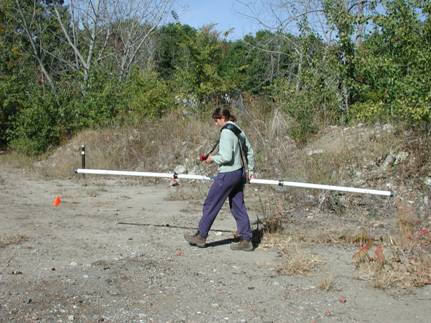The terrain conductivity survey is typically conducted using a Geonics Model EM31-DL Terrain Conductivity Meter, such as the one shown below. This induction-type instrument measures terrain conductivity without electrodes or direct soil contact. This technique operates on the principle that secondary electric and magnetic currents can be induced in metal objects and conductive bodies, such as USTs, sludge, and leachate when an electric field is applied. This instrumentation measures the secondary magnetic field strength relative to the primary magnetic field and converts it directly into a conductivity value, measured in milliohms per meter (mohms/m) and a resolution of 1 mohm/m.
The EM-31 also records the amount of phase-shift occurring between primary and secondary magnetic fields. The in-phase component measures that portion of the secondary magnetic field that is aligned with the primary field. Because metal objects are almost perfect conductors, there is sometimes no phase shift between primary and secondary magnetic fields. Hence, metal objects are detectable using the in-phase component (measured in parts per thousand or ppt). Additionally, in the presence of metal, conductivity values are often negative ("polarity reversals") and highly irregular.
The transmitting and receiving coils in the EM31-DL have a fixed separation of 3 meters when used in its normal operating mode (vertical dipole mode), achieves a depth of penetration of about 20 feet. The instrument response is more affected by near-surface than by deeper material, especially when used in the vertical dipole mode. Typically, conductivity and in-phase data are digitally stored and transferred to computer, where they are contoured.
Terrain conductivity surveys are subject to interference from above power lines and surface metal objects, such as trucks, fences, etc. Also, conductive materials, such as sludge or salt water, produce elevated conductivity values that may obscure buried metal, other objects of interest.
